Drawdown Georgia aims to accelerate progress toward net zero greenhouse gas emissions in Georgia. Our team of university researchers (from Georgia Tech, UGA, Emory, and Georgia State), and community partners (Southface Institute, Greenlink Analytics, Partnership for Southern Equity, and others) is providing a science-based approach to achieving the Drawdown Georgia goal.
Georgia Tech hosts this Drawdown Georgia Research Portal (with funding by the Ray C. Anderson Foundation). Visit the Drawdown Georgia website
Geospatial Tracking, Business Engagement, and Solution Activation
Track the GHG Footprint of GA Counties and Metro Areas
In the second phase of Drawdown Georgia, we are going to develop a geospatial system to track county- and metro-level, monthly greenhouse gas (GHG) estimates for Georgia. This system will focus on Georgia’s 159 counties and its energy-intensive sectors, e.g., electricity, transportation, buildings, and industry. On top of that, we would also estimate the amount of carbon emissions that are absorbed by Georgia’s forests and agricultural soils. These data will be visualized as an interactive map in a “Georgia Emissions Dashboard” where users can explore county-level data. By increasing GHG monitoring transparency, we can identify counties and sectors that are leading the state to carbon neutrality, those with large carbon footprints, and peers who can share winning strategies.
Engage Business on Drawdown Georgia
The Drawdown Georgia project has demonstrated that there is a path to significant carbon emission reductions in Georgia by 2030 across a set of high-impact solutions. To achieve these emission reductions, it is imperative to actively engage the business community. Lessons can be shared by gathering businesses together in a state-wide “climate club” where companies and NGOs can participate in collective GHG reduction commitments. These actors would have access to workshops and products that translate the technical Drawdown Georgia work into the language of business. In parallel, “beyond carbon” considerations would be integrated into the workshops to provide companies with a clearer vision of how adopting high-impact solutions can lead to job creation, social performance, and ecosystem sustainability.
Research to Activate and Track Climate Solutions
Supported by geospatial tracking of climate solutions, supporting infrastructure, business commitments, policy actions, and public opinions, our research is identifying key activation levers. Data from multiple sources are being used to identify public attitudes and stakeholder views, pathways to solutions adoption, barriers that inhibit progress, and the power of enabling infrastructure. These data are being visualized in dynamic, interactive maps linked to Drawdown Georgia’s emissions dashboard. Promising policies are being profiled, and climate solution action plans are being developed.
Recent Highlights:
May 13, 2024 Track+Scale Workshop on the Climate Solutions Tracker
On May 13, Drawdown Georgia and the Georgia Tech School of Public Policy hosted a workshop on tracking and scaling Georgia’s Climate Solution at the The Kendeda Building for Innovative Sustainable Design, with more than one hundred experts and stakeholders who divided into groups to learn about and “test drive” the beta version of our new Climate Solutions Tracker. Dr. Marilyn Brown gave an overview of the Solutions Tracker, and Bill Drummond gave an update on the Emissions Tracker. DeAnna Oser and Crystal Jackson, LEED Green Associate also referred to how Drawdown Georgia's work contributed to the climate action plans recently released by Georgia's Environmental Protection Division and the Atlanta Regional Commission. Marshall Shepard and John Lanier closed out the workshop with motivational talks about climate resilience and the importance of climate solutions. You can access all the slide decks shown during the workshop here.
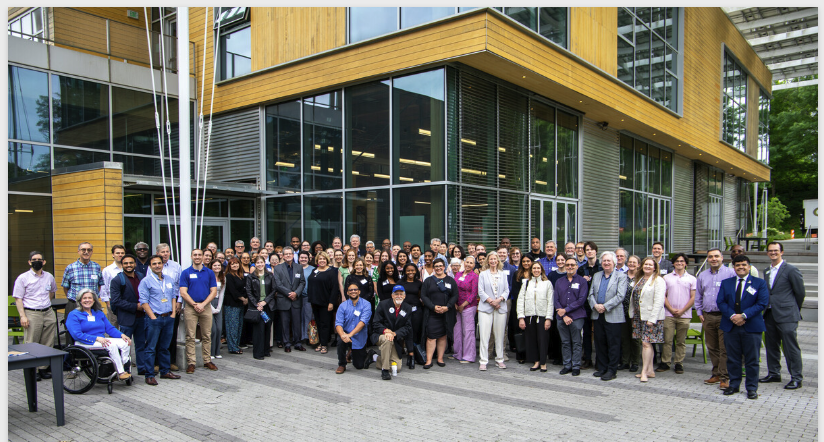
Since 2022, teams of Georgia Tech grad students have conducted research on high-impact climate solutions for Georgia. A selection of their reports and capstone papers are listed in the table below, by "sector" of the economy. Full documents are hotlinked to the titles. They all provide state-of-the-art information with some original calculations, assessments, and policy analytics.
Transportation | |||
2025 | Increasing Facilities to Maintain EV Fleets: A Proposal | 6701 | Jake Bryan, Heather Converse, Bridget Eilers, Abigail Henry, Maya Howayek, Shelby Platner |
| Expanding EV Charging Infrastructure: Local Government Community-Wide EV Charging Stations | 6701 | Jack Fenton, Aaron Fernandes, Emma Hudock, Bryce Johnson, James Leland, Destina Suren | |
| Local Government Fleet Transition from Fossil Fuel to Electric Vehicle | 6701 | Andrew Williams, Josh Renkin, Juntian Wang, Kunder Likhit N, Sai Sravya Kuraparthi, Tatyana Medina | |
| Marta railcar replacement program | 6701 | Brendan Hudgins, Caroline Sloan, Joshua Coffee, Ridhi Chaubey, Ryan Anderson, Mofoluke Obiri | |
| Regional E-Bike Rebate Program: Incentivizing Use of E-Bikes | 6701 | Adil Ali Khan | |
2024 | Statewide expansion of Atlanta-Regional Transit Link Authority’s (ATL’s) ‘Zero-Emissions Bus Plan | 6701 | Awa Dieye Kebe, Jacob Cumbie, John Harris |
| Analyzing factors affecting EV charging station ownership in Georgia | 6701 | Aaron Duhart, Megan Fannin, Wouter Van de Groep, Suprita Chakravarthy | |
| ZEV fleet deployment | 6701 | Adrian Mungroo, Aditya Narayanan, Muaaz Ahmad, Samir Ahmadyar | |
| Modeling the Impacts of 2024 EPA Clean Air Standards in Light-Duty Vehicles | MSEEM Capstone | Suprita Chakravarthy | |
2022 | EV charger infrastructure analysis in georgia | 6701 | Isaac Amponsah, Catherine Grey, Joseph Kern, Yifan Liu, Catriona MacGregor |
| US EV charging infrastructure | 6701 | Aditya Desai , Sahil Lala, Brandi Lewis , Arjun Thangaraj Ramshankar, Burhanuddin Samiwala, La’Darius Thomas | |
Electricity | |||
2025 | Increasing Solar PV on Local Government Facilities & University Campuses | 6701 | Karan Ravindra Gaikwad, Emily Carrillo, Hao Dong, Matthew Pilkay, Zekun Yang, Yiyang Zhang |
| Increased Use of Solar Photovoltaics (PV) Solar-Powered Central Energy Plant | 6701 | Rina Davila, Kevin Wu, Estatira Kahvazadeh, Rosemary Barrass, Mintiben Patel | |
2024 | Community Solar in Georgia | 6701 | Callie Hood, Ryan Piansky, Simeon Salia, Sabrina Westgate |
| The State of Rooftop Solar In Georgia: Policy Implications and Recommendations for Future Growth | 6701 | Giovanni Delgadillo, Camila Gonzalez, Marianus Kick, Hamidreza Nazemi | |
2022 | A Proposed Paradigm Shift of Demand Response in the Southeast | Utility Regulation | Christopher Contos, Mathias Zacarias, Samantha Morton, Alvaro Concha, Shavonn D’Souza |
| Prospect of Solar-Driven Ammonia Production: Technology, Distribution, and Policy Considerations | 6701 | Carlos Fernandez | |
| Feasibility of Wind Power in North Georgia | 6701 | Jose Marte, Keith Dowsett, Krissie Haddon, Santiago Juarez, Shannon Chen, Tom Cihota | |
| Assessing the Potential of Small Modular Reactors (SMR) in the U.S. | 6701 | Elliot Reid, Asher Mouat, Joe Caracciolo | |
Forest & Agriculture | |||
2025 | Priorities for Agroforestry in Sustainable Agriculture Policy: A Case for Silvopasture | MSEEM Capstone | Taylor Clarke |
2024 | Key Considerations and Analysis of Silvopasture Adoption in Georgia | 6701 | Shivaprakash Muruganandham, Hui-Tien Sun, Taylor Clarke |
2022 | Assessing the Feasibility and Sustainability of Agroforestry in Georgia | 6701 | Ashwin Jajoo, Camila Ziadi, Garrett Tallman, Troy Heinzmann |
| Renewable Resources on Poultry Farms in Georgia | 6701 | Emma Brodzik, Maria Lucas, Blake jones, lily smith, Osamuyi Obadolagbonyi, Ashok Sankaran | |
Waste Management | |||
2025 | Community Composting | 6701 | Sophie Lemaignen, Thomas Fuentes, Agustin Fleiderman, and Eric Greenlee |
2024 | Landfill Gas Recovery for Energy in the United States: A contextual case study of three states’ approaches | 6701 | Kelly Farmer, Rachel Isley, Fernando Karg Bulnes, Raj Patel |
2022 | Analyzing Circular Supply Chains for Electric Vehicle Battery Recycling | 6701 | Shubham Tandon, Shivtej Shete, Ruthwik Aki, Viraj Shah, Anush Oswal, Shlok Sharma |
Cross-Sector | |||
2025 | The Effects of Green Communities Program Implementation in Atlanta Metropolitan Statistical Area | 6701 | Yunyi Anderson, Hayley Capilitan, Emily Faltemier, Carolyn Payne, Om Shah |
2024 | Distributed Solar Energy and Electric Vehicle Virtual Power Plant Storage for Electric Cooperative and Municipal Utilities Nationwide | 6701 | Ellis Ewert, Kunal Krishnaswami, Ruth Murdoch, Sneha Sequeira |
| Establishing a Voluntary Carbon Offset Market in the State of Georgia | MSEEM Capstone | Timothy Sterling | |
National Academy of Sciences publication on Drawdown Georgia was highlighted at the NAS 2022 Annual Meeting. See the YouTube video of Dr. Marilyn Brown at the National Academies of Sciences, 4/30/22 here: Localized Roadmaps to Fight the Climate Crisis.
“A Framework for Localizing Global Climate Solutions and their Carbon Reduction Potential” shows how Georgia can reduce its carbon footprint by 50% in 2030 below its 2005 net emissions. With the roadmap produced by Drawdown Georgia, we can meet our fair share of the Paris Accord's science-based climate goals. The roadmap is aspirational, but also realistic. And it is attentive to the needs of Georgia's resource-constrained communities.
Achievable Abatement Potential for 20 Georgia Solutions

In Spring 2021, Georgia Tech Grad Students Studied Drawdown Georgia's High-Impact Solutions--Enjoy their 9 videos
Nine fantastic class projects offer valuable insights into Drawdown Georgia's high-impact solutions--technology overviews, market assessments, stakeholder perspectives, and policy options. The videos are hot-linked to each of the project titles below.
| Icon | Title | Group Members |
|---|---|---|
| Facilitating a Solarized Georgia | Paprapee Buason, Min-Kyeong (Min) Cha, Théo Davis, Parker Hamilton, Bethany Tate |
| Energy Burden Drawdown: How Georgia Can Promote Rooftop Solar with a Focus on Equity and Inclusion | Mohannad Alkhraijah, Mona Dandan, Nidhima Grover, Simon Key, Heather Null, Jennifer Wilson |
| Utility-Scale Solar: Maximizing Potential for the State of Georgia | Jessica Kuna, Hadassah Robbins, Hassan Haddad, Sonja Brankovic, Claire Cressman | |
| Utility-Scale Solar in Georgia | Kelsey Alexander, Maddy Bodiford, Nidhi Gangavarapu, Nifemi Moronkeji, Rich Stanzione | |
| Green Retrofitting in Georgia | Daniel Mactaggart, Garry Harris, Jayna Glover, June Fodor | |
| Transit Heat | Chiraag Vinod Bhawnani, PJ LoCicero, Geneva Rumer | |
| Assessing the Potential for Increased Electric Vehicles Use in the Context of Drawdown Georgia | Alejandro Owen Aquino, Bettina Arkhurst, Jonathan Drummond, Gunjan Gupta, Sooji Ha, Tucker Hembree, Niveda Shanmugam | |
| Energy Efficient Trucks in Georgia | Diana Burns, Hannah Griggs, Kayla Kelley, Lance Smith, Brooke Schuhle, Cristian Arguello |
| Land Sink Policy in Georgia | Madeline Shepard, Isaiah Borne, Brooklyn Mooney, Lauren Rister, Haylee Stanger |
Recent Events
Solve Climate by 2020, a webinar on April 7, 2021, focused on Drawdown Georgia: https://cepl.gatech.edu/climate-dialogue
Webinar on October 21, 2020 (2-3:30 pm ET): Watch the recording of "The Science Behind Drawdown Georgia"
2019-20: Selecting High Impact GA Solutions
1. Phase One Overview
2. Technical Review of 75 possible solutions for Georgia
The Academic Research team presented the findings of the carbon sinks and Mt CO2 reductions that are technically feasible to reach achieve a net zero GHG footprint and sell excess credits into carbon offset markets.
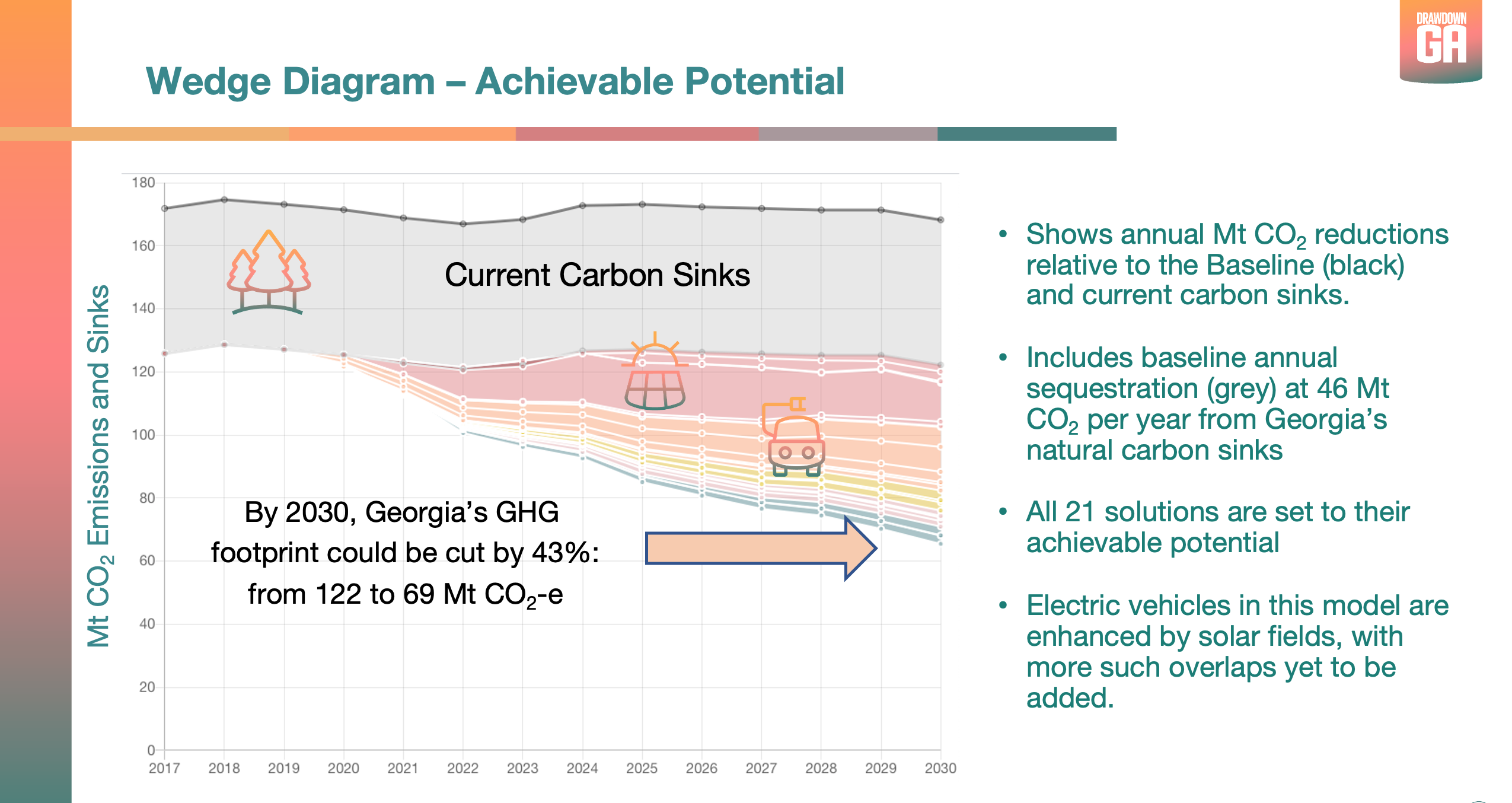
The Drawdown Georgia project was spotlighted in a half-day of activities at the August 6, 2020, Southface Institute’s Greenprints Conference. The project was introduced by John Lanier (Ray C. Anderson Foundation) and Daniel Rochberg (Emory University), then described in some detail by Marilyn Brown (Georgia Tech). Five high-profile Drawdown Georgia solutions were then introduced: Rooftop Solar (Marilyn Brown), Demand Response (Matt Cox), Composting (Sudhagar Mani), Retrofitting (Shane Totten), and Electric Vehicles (Rich Simmons). Before breaking into discussion sessions, Michael Oxman (Georgia Tech) described the Beyond Carbon considerations. The break-out discussions were synthesized in Miro Boards – characterizing Accelerators, Barriers, Beyond Carbon, and Promising Approaches. The participants offered lots of ideas and insights, which was a key goal of the event.
3. Down-select High Impact Solutions
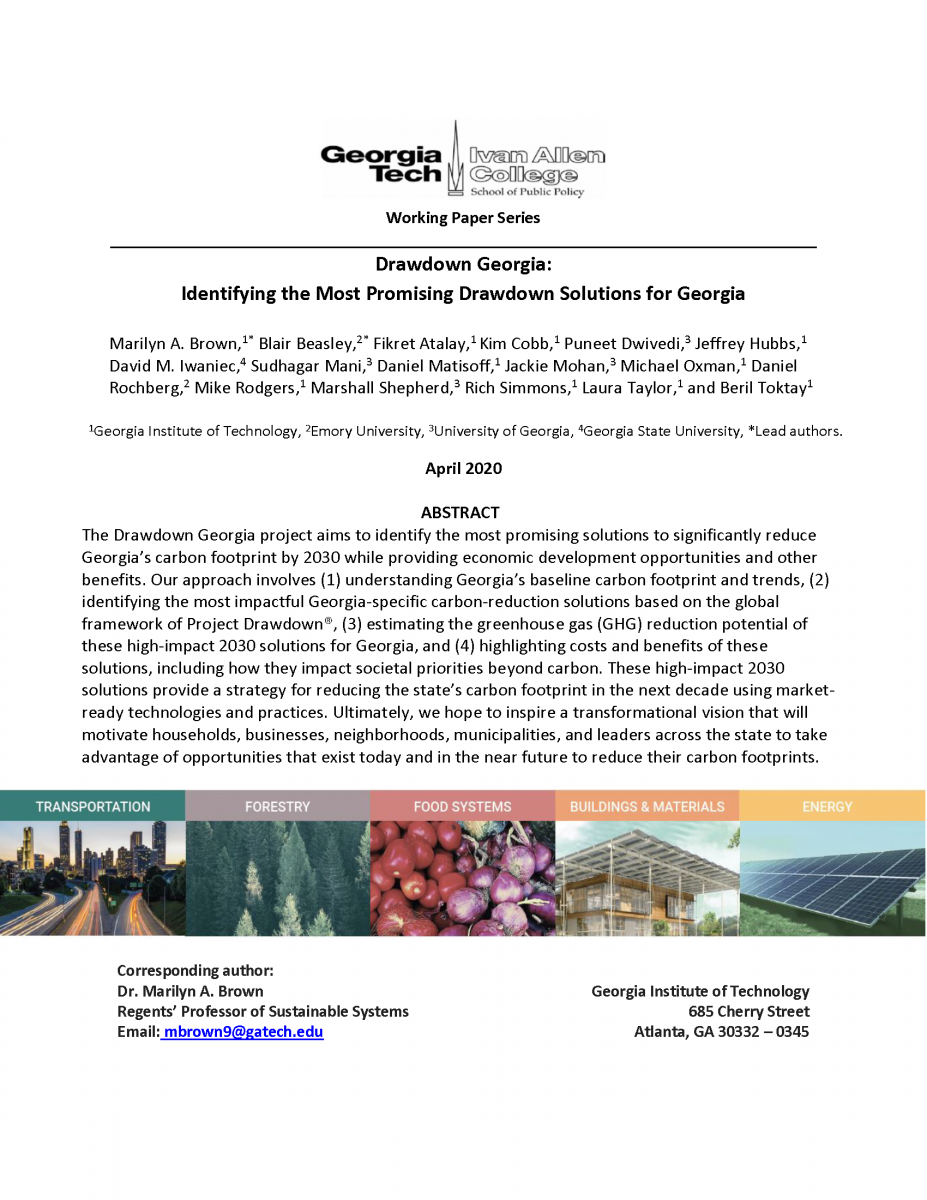

Read the Working Paper and Appendix
This working paper (on left) describes the first phase of our research, involving a fact-based assessment of Project Drawdown's solutions, to identify those that could significantly reduce Georgia’s carbon footprint by 2030. The Appendix (on right) includes logic diagrams, info sheets, and references describing 75 individual solutions. Below is a quick reference of the 20 high impact solutions, organized by sector, which are retained for further research into costs and benefits required for carbon drawdown.
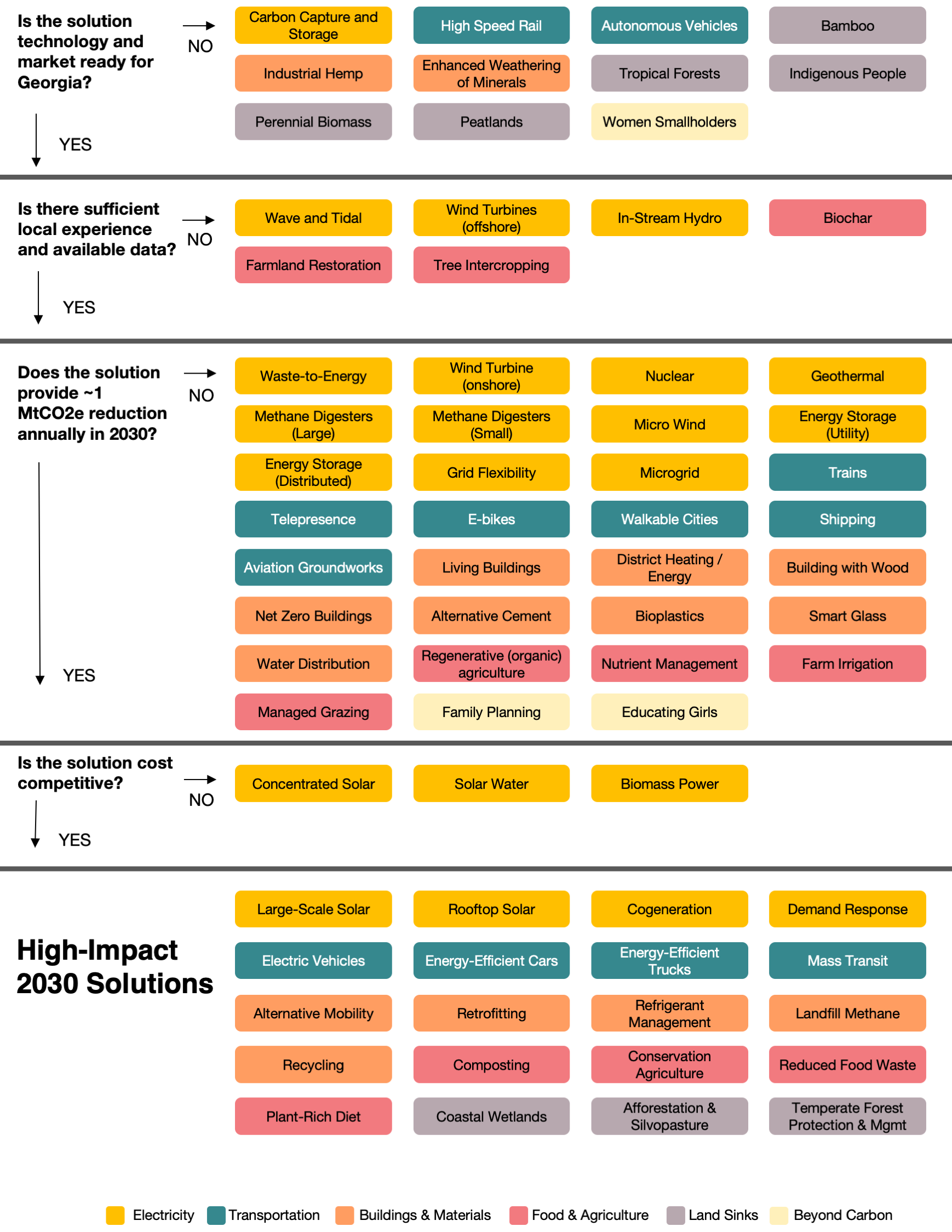
4. Detailed Analysis of 20 High Impact Solutions
20 Tech Briefs and Powerpoint Presentations
Electricity
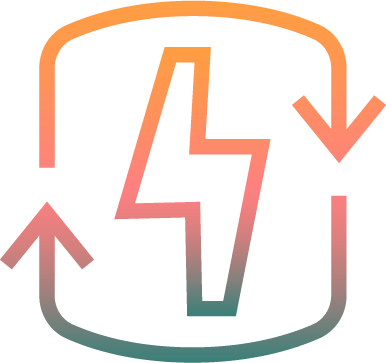 Cogeneration
Cogeneration
16 additional 25 MW cogen plants using waste heat to generate electricity Demand Response
Demand Response
187,000 households participate in a demand-response program, reducing 10% of their peak demand Rooftop Solar
Rooftop Solar
295,000 new 5 KW home solar systems Large-Scale Solar
Large-Scale Solar
10 additional 100 MW solar farms and 36 additional 5 MW community solar systems Landfill Methane
Landfill Methane
4 typical landfill facilities with 5 MW gas-to-energy systems
Transportation
 Alternative Mobility
Alternative Mobility
Eliminate 2.5% of car trips Electric Vehicles
Electric Vehicles
Replace 250,000 gasoline-powered vehicles with EVs Energy-Efficient Cars
Energy-Efficient Cars
Improve fleetwide fuel economy for light duty vehicles 3% Energy-Efficient Trucks
Energy-Efficient Trucks
Reduce diesel fuel use in medium and heavy duty trucks 10% Mass Transit
Mass Transit
320,000 additional households in Transit Oriented Developments
Buildings & Materials
 Retrofitting
Retrofitting
Retrofit 20% of Georgia’s homes to save 20% of energy Recycling /Waste Management
Recycling /Waste Management
Recycle at least 20% of current paper waste Refrigerant Management
Refrigerant Management
Retrofit refrigeration systems in all Georgia grocery stores to refrigerant leakage rate of 8%
Food & Agriculture
 Composting
Composting
Divert ~2 million tons of organic wastes including food waste from landfilling to composting by 2030 Conservation Agriculture
Conservation Agriculture
Adapt additional 1.6 million acres of croplands into conservation agriculture practices in Georgia Plant-Rich Diet
Plant-Rich Diet
25% of Georgia population shifts to plant-rich or low-carbon diets Reduced Food Waste
Reduced Food Waste
Reduce about 12% of current food waste
Land Sinks
 Temperate Forests
Temperate Forests
Increase forest cover by 3.4% with mixed tree species Afforestation & Silvopasture Plant 7% of current pastures with mixed hardwood & loblolly tree species using staggered planting times
Afforestation & Silvopasture Plant 7% of current pastures with mixed hardwood & loblolly tree species using staggered planting times Coastal Wetlands
Coastal Wetlands
Increase Georgia’s coastal wetland area by 71%
5. Directory to Multi-Disciplinary Workgroups
Six sector workgroups are comprised of faculty, researchers, and graduate students at four universities: Georgia Tech, University of Georgia, Emory University, and Georgia State.
Activities:
1. Hosted a Workshop at the Kendeda Living Building, Georgia Tech, November 6th, 2019

2. Presented workplans and preliminary results at the 2019 Georgia Climate Conference, Emory University
- Overview Presentation - Dr. Marilyn Brown
- Workgroups 1, 2, & 3 Progress - Dr. Rich Simmons
- Workgroups 4 & 5 Progress - Dr. Puneet Dwivedi
- Workgroup 6 Progress - Dr. David Iwaniac
